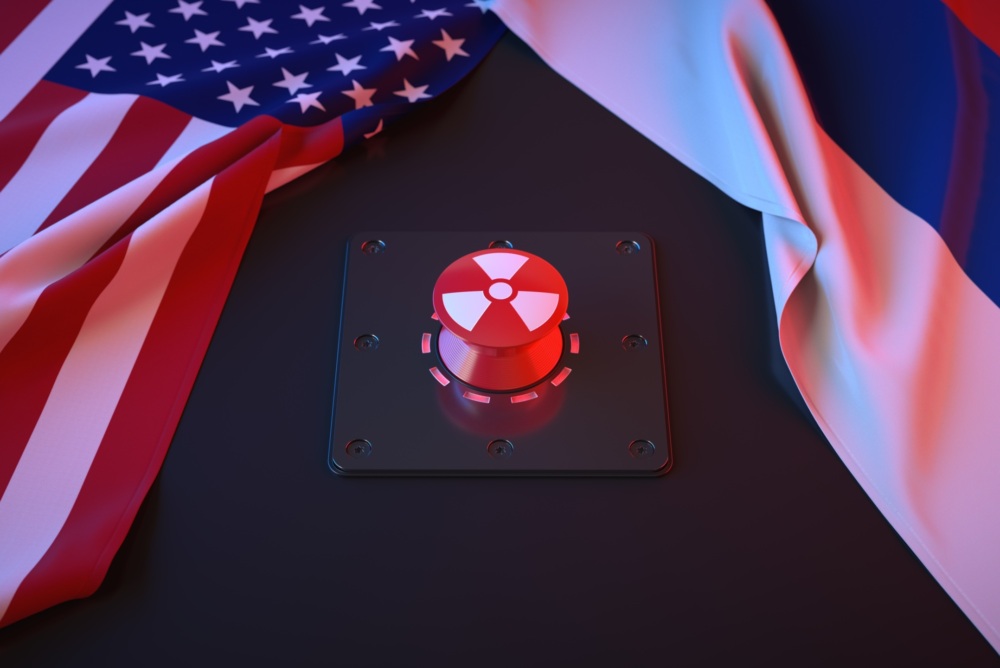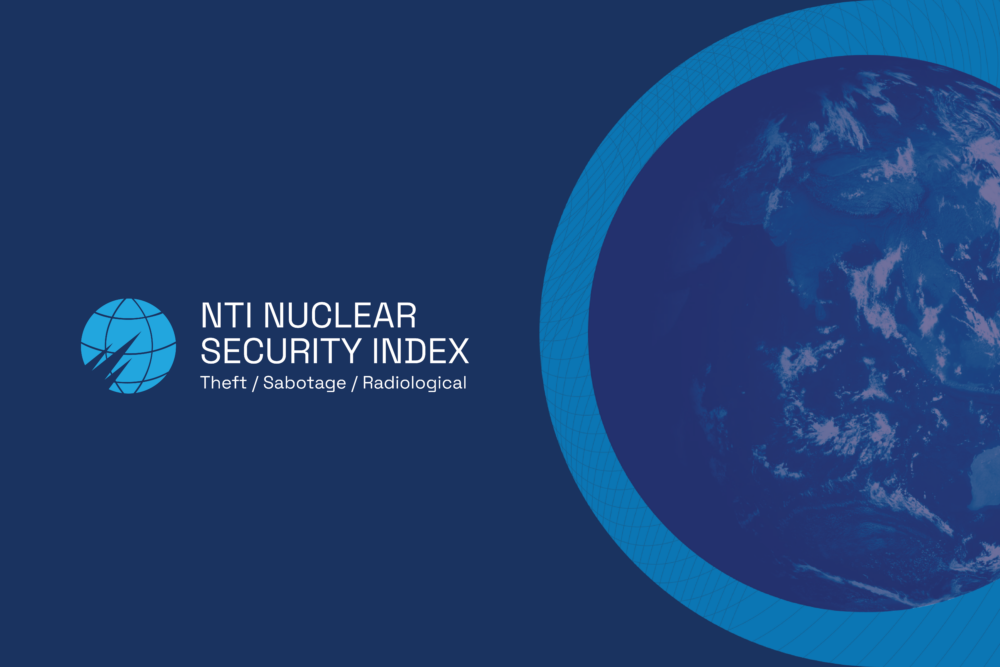Chairman Smith, Ranking Member Thornberry, members of the committee, thank you for the opportunity to appear before you today on an issue that affects the lives of every American and indeed the security of our world.
I serve as President and Chief Operating Officer of the Nuclear Threat Initiative, a non-partisan non-profit global security organization dedicated to reducing risks from weapons of mass destruction and disruption.
Today, we face the highest risk of use of a nuclear weapon since the Cold War, but, in contrast to that dangerous period in our history, today, this risk is not front and center in the minds of most Americans or their leaders.
We live in an era where a fateful error or miscalculation — rather than an intentional act — is the most likely catalyst to nuclear catastrophe. Reducing this risk demands the priority focus of those who are entrusted to represent the American people and ensure their security. I commend you for your leadership on these issues and thank you for the opportunity to share my views. As a former staff member of this committee, I know the important role this committee and the congress play in shaping our nation’s nuclear policies to reduce nuclear risks and ensure a safer, more credible nuclear policy and posture that is responsive to today’s threats.
In this testimony I urge Congress, and in particular, this committee to focus on action in four areas:
- Advancing a U.S. nuclear policy and posture intended to prevent the use of nuclear weapons and reduce reliance on them in our national security policy;
- Supporting policies and postures that increase decision time for U.S. and Russian presidents to respond to a warning of an incoming missile;
- Ensuring robust U.S.-Russia nuclear dialogue and crisis management mechanisms; and
- Encouraging steps to enhance strategic stability, including through the preservation of existing arms control mechanisms like the New Strategic Arms Reduction Treaty (New START) and the negotiation of additional verifiable bilateral and multilateral agreements.
U.S. Nuclear Policy for Preventing Nuclear Use
Although our vital national security interest in preventing nuclear use is clear, the world is now moving in the wrong direction, and U.S. nuclear policies have not kept pace. Today’s nuclear world—including a growing number of nations with nuclear arms in volatile regions, technological advances, the continuing threat of nuclear terrorism and cyberattacks—poses high and potentially unmanageable risks, including the dangerous possibility of an accident, mistake, miscalculation, or blunder by one of many nuclear-capable actors leading to nuclear use.
The United States should maintain a safe, secure and reliable nuclear deterrent as long as nuclear weapons exist. But in today’s era of growing nuclear risks, this alone will not guarantee the safety and security of the American people.
The nuclear policy and posture course Washington sets influences other nations. If the United States – the world’s greatest military power — decides it cannot defend itself without new nuclear weapons and threats of nuclear use, and forgoes our historic—and moral—commitment to reducing and ultimately eliminating nuclear dangers, it will encourage other nations to increase their dependence on nuclear weapons. This will come at a time when international efforts to discourage the spread of nuclear weapons are under severe challenge.
The 2020 Nuclear Nonproliferation Treaty (NPT) Review Conference will mark the 50th anniversary of the entry into force of the NPT, which remains the cornerstone of the global nonproliferation regime. Its legal obligations provide the regulatory framework for the peaceful uses of nuclear energy and help ensure responsible behavior by new and emerging nuclear suppliers. However, there is growing frustration and concern among states about the potential collapse of the nuclear nonproliferation order so painstakingly cultivated by the Treaty and its signatories over decades.
The United States has a unique responsibility and imperative to lead and set the right course. We must recognize that U.S. nuclear policies and deployment decisions that emphasize U.S. reliance on nuclear weapons, and that call for new, more capable or more “usable” types of nuclear weapons, are at odds with our national security interest in dissuading other states from pursuing nuclear weapons programs.
With these objectives and concerns in mind, I believe U.S. nuclear policy should:
- Reaffirm our vital national security interest in preventing nuclear use and state that the purpose of U.S. nuclear weapons is to deter the use of nuclear weapons by others. We should avoid issuing nuclear threats or a strategy for limited nuclear use, as this will encourage others to do the same. We should not expand the range of threats against which nuclear weapons might be used, as the 2018 Nuclear Posture Review does. For instance, explicitly or implicitly threatening nuclear response against “strategic” cyberattacks greatly increases the risks of miscalculation or blunder. NTI has called for the U.S. and Russian presidents to issue a Presidential Joint Declaration reinforcing the principle articulated by President Reagan in 1984 that a nuclear war cannot be won and must never be fought. This initiative could include other states with nuclear weapons, in particular the UK, France, and China.
- Reconcile strategic modernization of our nuclear forces in the context of our deterrence needs, overall defense budget priorities, and emphasis on increasing stability and reducing reliance on nuclear weapons over time. The President and Congress should support what is necessary for maintaining a safe, secure, and credible nuclear posture, while reducing the risk of nuclear use and avoiding unnecessary costs. Effective deterrence involves more than nuclear forces, and we must ensure that the difficult budgetary choices we make reflect the priorities that will allow us to deter and defend against the full range of threats to our national security and that of our allies, including sustaining the competitive edge of our conventional forces.
- Forgo new nuclear weapon types, capabilities, or basing options. Today, the United States has a robust nuclear deterrent—with a significant number of warheads on day-to-day alert—a flexible capability to deter nuclear use or destroy any potential nuclear adversary. The most immediate priority should be to structure and posture U.S. and Russian nuclear forces to deter nuclear use and reduce the risk of an accidental, mistaken or unauthorized launch. Against this backdrop, doctrines and/or postures that envision a warfighting role for nuclear weapons or a way to make these weapons more “usable” are particularly troubling. In this regard, the reported (and debated) Russian concept of “escalate to de-escalate” — i.e., limited nuclear use designed to create a pause in the conflict and open a pathway for a negotiated settlement on Moscow’s terms – and U.S. calls for more “usable” nuclear weapons make the world vastly more dangerous. Even taking into account Russian modernization programs, the United States does not need to build new nuclear weapons types with new capabilities, or to expand nuclear missions. Plans for new, more “usable” low-yield nuclear weapons increase the probability and risk of nuclear war.
- Reaffirm the vision of working toward a world free of nuclear weapons through practical, concrete steps that improve our security today. Continuing support for the vision of a world free of nuclear weapons is essential for America’s national security interests. It also helps us meet our commitments under the NPT. Every president of both parties since Richard Nixon has reaffirmed the commitments made in the Treaty to pursue nuclear disarmament, but non-nuclear weapon states have grown increasingly skeptical of the sincerity of the nuclear weapon states. To make progress on the vision, countries must implement a series of practical, achievable steps that continuously reduce the risks of nuclear use.
Increasing Decision Time for U.S. and Russian Presidents to Respond to a Warning of an Incoming Missile
Today, U.S. and Russian ballistic missiles armed with nuclear warheads deployed on prompt-launch can be fired and hit their targets within minutes. Once fired, a ballistic missile cannot be recalled. Leaders may have only minutes between warning of an attack and nuclear detonations on their territory that are intended to eliminate their capacity to respond. This puts enormous pressure on leaders to maintain “launch on warning/launch under attack” options, which, when mutual tensions persist or in a crisis, increases the risk that a decision to use nuclear weapons will be made in haste after a false or misinterpreted warning—blundering into nuclear catastrophe.
New cyber dangers to warning and command and control systems exacerbate that threat. Malicious hackers could simulate an attack – giving leaders in Washington or Moscow only minutes to decide whether to use or lose nuclear weapons in response to the potentially false warning of an incoming nuclear weapon.
Washington should work with Moscow to eliminate Cold War-era capabilities and force postures that generate fears of a disarming first-strike. Working with Russia to take nuclear missiles off prompt launch status would increase time for leaders to assess their options and make a more considered decision in response to a suspected or actual nuclear attack. This would significantly reduce the risk of a bad decision leading to nuclear use and set a precedent for all states with nuclear weapons to pull their finger back from the nuclear trigger.
Disengaging the Cold War autopilot would in no way diminish the U.S. military capability to deter and defend against any nation or combination of nations; even with these steps, the United States will continue to have sufficient if not excessive capacity in its nuclear arsenal. Over the years, Republican and Democratic presidents have expressed support for moving away from prompt-launch status. It is time to take this important step with Russia.
Possible options for increasing warning and decision time and removing weapons from prompt-launch include:
- Reciprocal U.S.-Russian commitments to remove a percentage of missiles and warheads from prompt-launch. The United States and Russia could announce plans to take a percentage of their strategic nuclear forces off prompt-launch within three to five years. Initial steps would also include discussions on procedures, observations, and inspections to build confidence and trust, which will be necessary to address the challenges involved in eventually removing all weapons from prompt-launch.
- Agreed tiered U.S.-Russian strategic force postures. The United States and Russia could limit the number of warheads on prompt-launch status to several hundred as part of a tiered force posture. This posture would have a first tier with a limited number of weapons on prompt-launch status, a second tier with delayed response of days or perhaps weeks, and a third tier that required longer periods to be brought back to readiness. The objective would be to move most strategic forces to the second and third tiers while ensuring against a situation where there is pressure in a crisis to rush to move forces back into the first tier.
- Set the goal of removing all nuclear weapons from prompt-launch status globally over the next decade. Progress on removing nuclear weapons from prompt-launch status in the United States and Russia could be the basis for a global norm against retaining or adopting prompt launch postures. The United States and Russia could begin a dialogue with other states with nuclear weapons in anticipation of a subsequent agreement not to deploy warheads on prompt-launch.
Complementary to removing weapons from prompt launch to increase warning and decision time for leaders, the United States should as a matter of policy promote secure, reliable, and survivable strategic nuclear warning and command and control systems. This should include discussions with Russia and other states with nuclear weapons for reaching understandings on reducing cyber threats to these systems.
Establishing ongoing U.S.-Russia Nuclear Dialogue and Crisis Management Mechanisms
Today’s situation of drastically curtailed channels of communication on nuclear issues between the United States and Russia is dangerous and must end. We have stark differences with Russia, but we have an existential common interest in reducing the risk of a nuclear mistake or blunder and avoiding a nuclear catastrophe. We need to be able to manage our considerable differences and engage on nuclear issues to protect the American people. If we could do it during the Cold War, we should be able to do it now.
Engaging Russia on crisis management, nuclear risk reduction and strategic stability is the crucial first step to reducing the risk of military conflict and nuclear use between the United States and Russia. We should re-establish as a core principle the goal of reducing the role and risks of nuclear weapons in global security policies as an essential part of Washington’s and Moscow’s overall security posture without jeopardizing the security of either country or their allies—and develop specific steps consistent with this core principle. In addition to nuclear forces (strategic and nonstrategic), renewed dialogue on strategic stability must include over time missile defenses, prompt-strike capabilities, conventional forces, cybersecurity, and activities in space.
The United States and Russia should work bilaterally to begin and advance key elements of an agenda to reduce the risks of nuclear use, but Europe and Asia, as well as all nuclear states, will also need to be engaged, and their perspectives taken into account. An immediate priority should be to identify concrete, practical, near-term initiatives designed to reduce risks, rebuild trust, and improve today’s global security landscape. These near-term steps should be presented so that publics understand how they enhance mutual security.
Leaders must act to resume and broaden military-to-military communication in multiple channels and at multiple levels. Elevating bilateral military-to-military dialogue between the United States and Russia, essential throughout the Cold War, should be an immediate and urgent priority. Within the Euro-Atlantic region, NATO-Russia channels should be better utilized, and they could be augmented by a new military crisis management group that could include other regional states. The focus of these initiatives should be on reducing risks of a catastrophic mistake or accident by restoring communication and increasing transparency and trust—an initiative that publics would understand and support.
As NTI Co-Chairs former Senator Nunn and former Secretary of Energy Moniz wrote in their February 1, 2019 op-ed in Politico, Congress has a unique role and responsibility to help shape U.S. policy on Russia at a time when this set of issues is so fraught in our domestic politics. They recommended establishment of a bicameral, bipartisan liaison group to work with the administration on a shared approach to policy on Russia and nuclear risk reduction, modeled loosely after the Senate Arms Control Observers Group in the1980’s.
The administration and Congress should agree to support restoration of robust crisis-management and nuclear stability discussions in military and diplomatic channels and must also work together to ensure sanctions are both effective and flexible. Specifically, Congress must give the President flexibility to lift sanctions if progress is made on restoring security in Ukraine and to our elections – sanctions are only an effective incentive to change Russia’s actions if Moscow believes those sanctions can and will be lifted in response to positive steps by Russia. Finally, Congress should lead a resumption of U.S.-Russian inter-parliamentary exchanges to have more face to face discussions between members of Congress and their Russian counterparts to discuss the challenges in the bilateral relationship as well as opportunities to advance mutual interests. These matters are too important to be caught up in partisanship or to await the outcome of the Mueller investigation.
Another priority is to restore cooperation and rebuild trust between the U.S. and Russian nuclear establishments. The U.S. Department of Energy (DOE) and Rosatom no longer cooperate in essential areas, such as nuclear security, nuclear safety, and nuclear environmental remediation. Attention should be focused on re-establishing the legal basis for DOE and Rosatom to work together to reduce nuclear danger, including by repealing congressional limitations on mutually beneficial DOE-Rosatom engagement and by encouraging the Administration to take steps to resume bilateral engagement under the 2013 U.S.-Russia Nuclear Research & Development Agreement.
In that spirit, I’d like to note some concrete things this committee could consider as you develop the FY2020 National Defense Authorization Act (NDAA).
- First, repeal limitations on military-to-military contact between the United States and Russia. While the FY2019 NDAA usefully included language exempting dialogue for the purpose of reducing the risk of conflict from the limitations, in practice the general restriction continues to suppress U.S.-Russian engagement that can contribute to strategic stability. I respectfully urge you to consider adding language to the NDAA specifically encouraging such urgently needed dialogue, which should take place more regularly and at multiple levels in DoD and State Department channels, as well as at NATO.
- Second, repeal provisions that prohibit the availability of funds for DOE programs in the Russian Federation. As the world’s largest nuclear powers, the United States and the Russian Federation have a shared responsibility to manage the destructive forces of the atom while directing those same forces toward positive applications. Restrictions such as those found in prior year NDAAs have had a chilling effect on both the U.S. and Russian bureaucracies, well beyond their literal application, and have prevented mutually beneficial cooperation on nuclear-related matters.
At the Munich Security Conference last month, more than forty former and current senior officials and experts (including three former Supreme Allied Commanders of Europe) issued a statement expressing support for crisis management dialogue and strategic stability in the Euro-Atlantic region. With your permission, I will submit for the record this statement by the Euro-Atlantic Security Leadership Group (EASLG).
The statement was discussed at an event during the Munich Security Conference attended by over 70 participants including Speaker Pelosi and several House Members, NATO’s Supreme Allied Commander, the Russian Deputy Foreign Minister, and many other senior current and former officials from the United States Europe and Russia. Based on the discussion at Munich, we believe there is a basis for governments to engage productively on this issue as a practical concrete step to reduce risks and begin the process of rebuilding trust in Europe. This could not be more urgent.
Enhancing Strategic Stability and the Role of Arms Control and Verification
In addition to resuming robust dialogue in military-to-military channels, the United States should continue to support and advance practical, concrete steps that reduce nuclear dangers, increase security, and sustain progress toward a world free of nuclear weapons. Historically, bilateral and multilateral nuclear arms control and confidence-building measures have played a significant role in advancing these objectives. However, the foundation of arms control and confidence building that has curbed the nuclear arms race and enhanced strategic stability between the nuclear superpowers during and after the Cold War is eroding and in danger of collapse.
Preserving and revitalizing this foundation is critical to continue progress in verifiably reducing global nuclear stockpiles, preventing proliferation, and increasing stability—including specific steps that could supplement legally binding treaties. To this end, the United States should: 1) extend the New Strategic Arms Reduction Treaty (New START) with Russia and pursue further verifiable nuclear reductions with Russia; 2) work with allies and Russia on an approach that will seek to avoid worst case destabilizing outcomes if, as it seems now, the Intermediate-Range Nuclear Forces Treaty (INF) will expire following U.S. withdrawal in response to Russia’s violation; 3) invigorate dialogues with Russia, China, the P-5, and all states with nuclear weapons to advance strategic stability as well as the reductions and limitation process; and 4) continue to collaborate with other states and experts to develop the verification tools needed for agreements that should in the future address not only delivery vehicles, but also nuclear warheads and the entire nuclear fuel cycle.
To advance some of these objectives, we recommend steps including:
- Preserving and Extending the New START Treaty. Through its numerical limits, robust verification and transparency measures including numerous on-site inspections and exhibitions; data exchanges and notifications related to strategic offensive arms and facilities covered by the Treaty; and provisions to facilitate the use of national technical means for Treaty monitoring, New START contributes immeasurably to the national security of the United States. Both sides are complying with New START and would benefit by extending its duration through 2026, as the Treaty permits. This is even more important if, as now seems likely, the INF Treaty will go out of force. The implementation issues that each side has raised with New START – pertaining to U.S. conversion procedures and the Treaty’s applicability to new kinds of strategic systems such as those Russia is developing – can and should be discussed in the Treaty’s implementing body. The loss of New START’s limits, verification regime, and the predictability it provides would do irreparable harm to mutual security. This can and must be avoided. Moreover, New START provides an essential foundation of limits and verification upon which additional measures can be pursued, and it can be supplemented or superseded by a future agreement that must have similarly robust verification and would, ideally, entail further nuclear reductions.
- Supporting Further Reductions. Reducing nuclear dangers and advancing nuclear nonproliferation requires that the United States continue to plan for, pursue, and help create the conditions conducive to further bilateral and multilateral nuclear arms reductions and limitations, and other measures such as a multilateral fissile material cut-off treaty, to advance step-by-step progress toward the ultimate goal of a world free of nuclear weapons. Further progress on nuclear reductions with Russia will require addressing a broader set of issues affecting strategic stability. As the reductions process proceeds, it will be necessary and desirable to involve additional countries with nuclear weapons and to address not only nuclear weapons delivery vehicles but also nuclear warheads and materials.
- Strengthening Verification. Verification is a critical component for strategic stability and for confidence in the nuclear reductions process. The challenges and requirements for verification become more demanding to support reduction agreements with lower numbers that regulate not only weapons delivery vehicles but also nuclear warheads and the materials required for producing and maintaining them. Significant effort and resources are being devoted across governments, academia, and other non-governmental organizations to strengthening verification. This work should be intensified and allocated sufficient resources to ensure the verification challenges are understood and met as progress on bilateral and multilateral reductions and limitations proceeds.
- To that end, NTI is engaged with the U.S. Department of State in leading efforts with a group of more than 25 States with and without nuclear weapons on the International Partnership for Nuclear Disarmament Verification (IPNDV). This collaborative effort is focused on identifying the challenges associated with nuclear disarmament verification and identifying potential procedures and technologies to address those challenges. The IPNDV is an example of how the public and private sectors can join together on a global basis to make practical contributions to the field of disarmament and its essential verification component.
- Engaging in Nuclear Dialogue with China. Regular and sustained bilateral nuclear dialogue between the United States and China is also essential for building transparency and trust and reducing risks of miscalculation and blunder. This is all the more important as China modernizes its nuclear forces, and in light of the potential for miscalculation or conflict with regard to the South China Sea or Taiwan. In addition, North Korea’s nuclear and missile programs continue to be a top priority for discussions. Washington and Beijing must be actively engaged on regional security issues and on goals and strategy for negotiations with North Korea.
Conclusion
I commend the committee for holding this timely hearing. Congress has a critical role to play through oversight and priority-setting through budgets to ensure that the United States is at the forefront of global efforts to prevent nuclear proliferation and to ensure that the 74-year record of non-use of a nuclear weapon since Hiroshima and Nagasaki continues indefinitely. The focus today must be on reducing the risk of an accident, mistake or miscalculation. There is much that can be done to prevent nuclear use and continue on the step-by-step approach of practical steps to reduce and ultimately eliminate nuclear weapons, but it will take U.S. leadership and global political will to get there.



